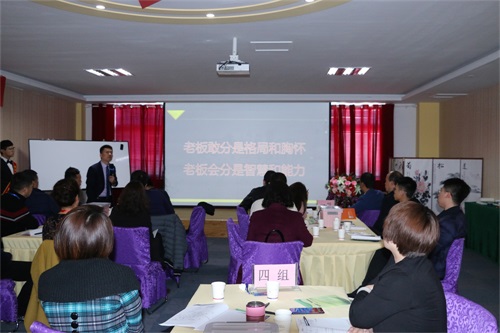在現(xiàn)代商業(yè)環(huán)境下,,股權(quán)制度是常見的組織模式,,幾乎每家成熟企業(yè)都有關(guān)于股權(quán)制度的完整設計,。然而,在應對當今時代的諸多挑戰(zhàn)時,,股權(quán)制度的效果卻難以體現(xiàn),。盡管很多企業(yè)家對股權(quán)制度進行了革新,其效果仍然平平,。下面
山東股權(quán)合伙企業(yè)為您分析:
In the modern business environment, the equity system is a common organizational model. Almost every mature enterprise has a complete design of the equity system. However, in dealing with many challenges of the current era, the effect of the equity system is difficult to reflect. Although many entrepreneurs have reformed the equity system, the effect is still flat. The following is the analysis of Shandong Equity Partnership:
合伙人模式與股權(quán)對比
Partner model and equity comparison
以股權(quán)激勵為例,,很多企業(yè)家猶豫許久,終于下定決心拿出股權(quán)激勵員工希望員工能夠站在領(lǐng)導的角度,,為企業(yè)發(fā)展做貢獻,。但真的能夠產(chǎn)生這樣的果嗎?在股權(quán)激勵的實踐中,,領(lǐng)導占股往往高達70%~90%,,甚至更高;而在權(quán)激勵制度下,員工個體占股大多難以達到1%,,甚至只有0.1%,。
Taking equity incentive as an example, many entrepreneurs hesitated for a long time and finally decided to use equity incentive to encourage employees to make contributions to the development of enterprises from the perspective of leadership. But can it really produce such results? In the practice of equity incentive, the share of leaders is often as high as 70%~90%, or even higher; However, under the power incentive system, the individual share of employees is difficult to reach 1%, even only 0.1%.
占股如此之低的員工,當然不會將自己代入到領(lǐng)導的角色,,因為這么少股權(quán)既不會給予他們經(jīng)營權(quán),,也不會賦予他們決策權(quán)。與此同時,股權(quán)激勵通常表現(xiàn)為一-種長效激勵模式,,是一種用未來激勵下的制度,。這就很難激勵更加關(guān)注當下價值的員工。正是由于權(quán)與利的缺失,,股權(quán)激勵在實踐中無法發(fā)揮應有的激勵作用,。
Of course, employees with such a low share will not replace themselves as leaders, because such a small share will not give them the right to operate or make decisions. At the same time, equity incentive is usually shown as a long-term incentive model, which is a system under the future incentive. It is difficult to motivate employees who pay more attention to the current value. Because of the lack of rights and interests, equity incentive cannot play its due role in practice.

對于企業(yè)而言,當企業(yè)將股權(quán)給予員工之后,,這份股權(quán)就已經(jīng)受到法律保護如果缺乏完善的制度設計,,企業(yè)也難以反悔、將股權(quán)收回,。市場環(huán)境正在發(fā)生巨變,,股權(quán)制度卻逐漸失...正.是在這樣的時代青下,合伙人模式重新進入了企業(yè)家的視野,,成為應對時代變局的一劑良藥,。
For an enterprise, after the enterprise gives the equity to its employees, the equity has been protected by law. If there is no perfect system design, the enterprise can hardly retract and withdraw the equity. The market environment is undergoing great changes, but the equity system is gradually losing It is in this era that the partnership model has re-entered the vision of entrepreneurs and become a good medicine to cope with the changes of the times.
股權(quán)的價值取向就在于資本,企業(yè)需要的是股東的資金,,而股東的投資回報則單純來自企業(yè)經(jīng)營的稅后凈利潤,。這就意味著,即使領(lǐng)導愿意將自己的所有權(quán)切割一部分出來,,對方也會顧慮企業(yè)的盈利能力,,甚至對股權(quán)產(chǎn)生排斥情緒。
The value orientation of equity lies in capital. What enterprises need is the capital of shareholders, and the return on investment of shareholders is purely from the after-tax net profit of enterprise operation. This means that even if the leaders are willing to cut part of their ownership, the other side will also worry about the profitability of the enterprise, and even have an aversion to equity.
即使企業(yè)年度稅后凈利潤高達1000萬元,,擁有0.1%股權(quán)的員工,,股權(quán)分紅也只能分得1萬元。而更大的可能,,則是企業(yè)在盈利線附近徘徊,,員工不僅可能無法分得收益,甚至可能面臨股權(quán)價值的貶值,。
Even if the annual after-tax net profit of the enterprise is as high as 10 million yuan, employees with 0.1% equity can only get 10000 yuan of equity dividends. The greater possibility is that the enterprise is hovering around the profit line. Employees may not only be unable to share the income, but may even face the depreciation of the equity value.
面對股權(quán)制度的種種缺陷,,即使領(lǐng)導想要革新,其往往也會因為嚴格的法律規(guī)定和傳統(tǒng)思維而無能為力,。
In the face of various defects in the equity system, even if leaders want to innovate, they are often powerless because of strict legal provisions and traditional thinking.
相比而言,,合伙人模式則以經(jīng)營權(quán)作為激勵手段,任何有價值貢獻的員工,,都能參與到企業(yè)經(jīng)營當中,。其實,企業(yè)經(jīng)營也正是依靠員工的價值貢獻,。因此,,合伙人模式能夠充分挖掘人本的價值,,滿足企業(yè)、領(lǐng)導和員工等各方的利益需求,。
In contrast, the partner model takes the management right as an incentive means, and any employee with valuable contributions can participate in the enterprise operation. In fact, enterprise management also depends on the value contribution of employees. Therefore, the partnership model can fully tap the value of humanism and meet the interests of enterprises, leaders and employees.
而在新時代的變局中,,由于合伏制度具有更高的靈活性,企業(yè)可以靈話設合伙人裂變與股權(quán)密碼定股份分配與占比,,也可以自我設定以超額業(yè)績,、基準利潤與超額利潤為數(shù)據(jù)做增量分配的激勵制度。在這樣的過程中,,企業(yè)不僅可以挖掘價值,、融合資源、還能激發(fā)潛力,、達成共識并形成共贏局面,。
In the changing situation of the new era, due to the higher flexibility of the combined system, enterprises can flexibly set partner fission and equity code to determine the share distribution and proportion, and can also set the incentive system for incremental distribution based on the data of excess performance, benchmark profit and excess profit. In this process, enterprises can not only tap value, integrate resources, but also stimulate potential, reach consensus and form a win-win situation.
企業(yè)無論處于何種發(fā)展階段,,都可以根據(jù)自己的需求設計合伙人模式,。因為合伙制是根據(jù)每個團隊不同的貢獻進行設定的:可以是核心人才事業(yè)合伙人,可以是業(yè)務合伙人,,也可以是內(nèi)部的合伙人,,同時也有可能是獨立的外部合伙人等。有些項目,,可以合資成立公司,,達成股權(quán)合作模式,通過這個模式來合作,,股權(quán)利益分成,。同時在后續(xù)的資本運作中也可以做股權(quán)置換。
No matter what stage of development an enterprise is in, it can design a partner model according to its own needs. Because the partnership is set according to the different contributions of each team: it can be a core talent business partner, a business partner, an internal partner, and an independent external partner. For some projects, joint ventures can be established to achieve equity cooperation mode. Through this mode, cooperation and equity interests can be shared. At the same time, equity replacement can also be done in the subsequent capital operation.
合伙人模式更具有融合性,、共贏性,、爆發(fā)性,充分挖掘人本價值,,在某些領(lǐng)域,,人本或?qū)⒊劫Y本,合伙人大會也將高于股東大會,。在該模式下,,合伙人也更具有分享性,企業(yè)模式可以更輕,,合伙人也更容易切入合作,。更多相關(guān)內(nèi)容就來我們網(wǎng)站
http://zyvd.cn咨詢了解吧!
The partnership model is more integrated, win-win and explosive, fully exploiting the value of humanism. In some fields, humanism may surpass capital, and the general meeting of partners will also be higher than the general meeting of shareholders. Under this model, partners are also more shareable, the enterprise model can be lighter, and partners are easier to enter into cooperation. Come to our website for more relevant content http://zyvd.cn Ask about it!



 13698613138
13698613138


